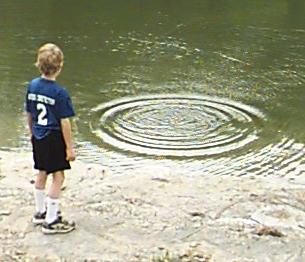
When you throw a stone into a still pond, you create a wave on the surface that spreads out in the form of a pattern of growing rings. The pattern can be characterized in several ways: the rings have a spacing, which is called the wavelength; they move outwards with a measurable speed; and as they pass they cause a leaf on the surface to bob up and down, and the rate (number of bobs per minute) is called the frequency.
Light has similar features , though it is a radio wave, instead of a water wave. The wavelength for light is very short -- about 1/40,000 of an inch for visible light -- which is so small that we usually do not notice that it has any size at all. The waves also travel very fast: 186,000 miles per second: "around the world 7 times" as fast as you can say it!
The difference between visible light and the waves that carry radio and TV signals is just a matter of wavelength and frequency. A typical FM radio station broadcasts at 100 Megahertz, which means that the waves change back and forth 100,000,000 times per second; visible light is 500,000,000 Megahertz. As you tune the radio from one end (86 Megaherz) to the other (106 Megahertz), you are moving towards the range of visible light -- but you have a long ways to go!